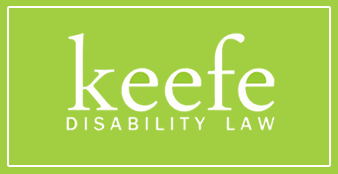
As we enter a new year with new possibilities, it’s also time to think about setting New Year’s resolutions. If you’ve been unable to work due to disability, it’s time for Social Security Disability Insurance (SSDI). Applying for SSDI can help provide the financial stability you need to pay your bills in 2024. Here at Keefe Disability Law, we are passionate about getting you the benefits you are entitled to receive.
Important Information Before Applying for SSDI
Whether you are a younger applicant or are closely approaching retirement age in 2024, it’s important to know about some of the crucial details of the SSDI program. For example, you should confirm you are eligible to receive benefit payments. You should also have a good idea of how the SSDI application process works.
Social Security Disability Eligibility Criteria
To qualify for Social Security Disability Insurance (SSDI), you must have a disability that prevents you from working. This disability must be expected to last at least 12 months or end in death. Along with medical requirements, you must also meet the non-medical requirements for SSDI. These include:
- Be a U.S. citizen, permanent resident, or active U.S. military
- Have worked jobs or self-employment covered by Social Security
- Have paid Social Security taxes during employment
- Be between 18 and 65 years old
- Are not currently engaged in substantial gainful activity (SGA)
- Have earned the minimum number of Social Security work credits
- Apply before your date last insured (DLI)
Average SSDI Monthly Benefit Amounts
The amount of your monthly Social Security disability payments depends on your lifetime insurable earnings. In effect, monthly SSDI payment amounts are equivalent to what you’d receive as retirement benefits. The difference, of course, is that you are getting these monthly payments before reaching your full retirement age.
The average monthly SSDI payment is around $1,300. The amount is based on your average indexed monthly earnings (AIME). The SSA has a free online calculator to estimate how much you may be entitled to receive.
Typical Timeframe for Initial Decisions
If you think you are eligible for disability benefits, apply right away. The wait for a Social Security disability decision can take a while. You may not hear back from the Social Security Administration (SSA) for several months. The average wait time in 2022 was over six months. Even so, you may be eligible for back pay, going back to your original application date.
SSDI Denials and Appeals Process
The wait to hear back from the SSA can be challenging. Worse yet, the SSA denies the majority of claims the first time around. Many of these SSDI denials are due to technical errors. Others are because of a lack of medical evidence. By working with John Keefe and the team at Keefe Disability Law, we can help you avoid these common mistakes and omissions.
You may appeal the decision if the SSA initially denies your claim. However, the appeals process can take even longer. Because of a backlog of cases, the appeals process can take months or even years to complete with no guarantee of success. Even so, it’s vital to get the benefits you deserve. Our skilled legal team is here to help.
Required Documentation and Proof of Disability
The application process for SSDI can feel intimidating at first. You need to document your disability to the SSA’s satisfaction. Plus, you need to provide a lot of supporting documentation. Among the documents and information you need to include in your claim are:
- Birth certificate or proof of citizenship
- Your Social Security number (SSN)
- W-2 forms or self-employment tax returns
- Other employment history and earnings information
- Names and addresses of past employers
- Educational background
- Proof of any workers’ compensation benefits you’ve received
- Adult Disability Report
- Medical evidence, like doctor reports and lab test results
- Information about your spouse (if applicable)
- Information about your minor children (if applicable)
- Your banking information for direct deposit
- The onset date of your disability that prevents you from working
This list is not exhaustive. As you fill out your SSDI application, it may ask for more information or documentation. Your disability attorney can guide you through this process.
SSA Blue Book Listings and RFC Assessments
Some of the most important parts of your SSDI application are for proving the extent of your disability. You need to clearly show how your condition stops you from being able to work. It needs to be severe enough to prevent you from substantial gainful activity. There are two routes to do this.
First, you can find a listing in the official SSA Blue Book. The book details a wide range of qualifying disabilities. Examples include cardiovascular disorders, mental disorders, and disorders of the respiratory system. If you meet a listing’s requirements, you may be eligible for SSDI. You may qualify for SSDI with asthma, cancer, or PTSD, for instance.
If your condition is not listed in the Blue Book, you may qualify through a RFC form. A residual functional capacity (RFC) assessment examines your physical and mental abilities. It grades what you can and cannot do. The results of an RFC assessment may be relevant when looking at the combined effect of multiple conditions. You may not qualify for SSDI under a single Blue Book listing. But, taken together, the impact of more than one disorder may prevent you from working.
Three Ways to Apply for SSDI Benefits
You have three main options to get started with your New Year’s resolution to apply for SSDI benefits. You can apply online, by phone, or in person.
Applying Online
The most convenient way to apply for SSDI is online. The SSA has set up a secure website specifically for this purpose. Because it’s online, you can do this from the comfort of your home, any time of day. You do not need to complete the application in a single session. You can save it and finish it later. Work with Keefe Disability Law to ensure you are completing your claim correctly. We can guide you through filling out these forms.
Applying by Telephone
Another way to apply for disability benefits is by calling the Social Security Administration. The national toll-free phone number is 1-800-772-1213. The TTY number is 1-800-325-0778. This can be a more time-consuming process as the operator goes through the various forms with you. You may or may not be able to complete your claim in multiple sessions if your information is incomplete or not ready.
Applying in Person
A third option is to visit your local Social Security office. This can be less convenient. Your disability may limit your mobility. Or, you may live far from an office. On the bright side, a representative will assist you with your application. While you do not need to make an appointment, scheduling one will reduce waiting times. If the office is busy, you may have to wait a while.
Professional Help With the Application Process
Realistically, applying for disability benefits can be confusing, grueling, and frustrating for many people. It’s easy to get lost in jargon, forms, and requirements. To improve your chances of approval, it’s prudent to hire an experienced disability lawyer. Keefe Disability Law offers years of experience, working with countless SSDI clients to get the benefits they deserve.
We will proactively seek out the medical evidence to support your claim. We can make sure your application is complete, and you do not miss any filing deadlines. All along the way, we can answer any questions you may have. For example, you may be able to work a little while maintaining SSDI eligibility. We can explain what substantial gainful activity means or how trial work periods work.
You do not need to do this alone. At Keefe Disability Law, we are happy to offer professional help and advice.
Other New Year’s Resolutions to Consider
Along with applying for SSDI, you may have other New Year’s resolutions in mind. A new year presents opportunities for a fresh start. From small tweaks to big changes, here are a few ideas for possible New Year’s resolutions in 2024:
- Start a journal
- Improve your diet
- Review your budget
- Update your will
- Learn a new skill
- Join a community group
- Take a class
- Begin a hobby
- Practice mindfulness

